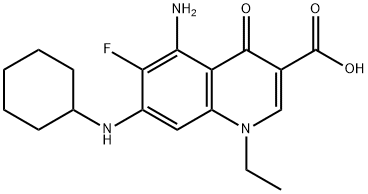SAFETY INFORMATION
| Signal word | Danger |
|---|---|
| Pictogram(s) |
 Exclamation Mark Irritant GHS07  Health Hazard GHS08  Environment GHS09 |
| GHS Hazard Statements |
H302:Acute toxicity,oral H372:Specific target organ toxicity, repeated exposure H410:Hazardous to the aquatic environment, long-term hazard |
| Precautionary Statement Codes |
P260:Do not breathe dust/fume/gas/mist/vapours/spray. P264:Wash hands thoroughly after handling. P264:Wash skin thouroughly after handling. P273:Avoid release to the environment. P501:Dispose of contents/container to..… |
COMPUTED DESCRIPTORS
| Molecular Weight | 347.4 g/mol |
|---|---|
| XLogP3 | 3.6 |
| Hydrogen Bond Donor Count | 3 |
| Hydrogen Bond Acceptor Count | 7 |
| Rotatable Bond Count | 4 |
| Exact Mass | 347.16451973 g/mol |
| Monoisotopic Mass | 347.16451973 g/mol |
| Topological Polar Surface Area | 95.7 Ų |
| Heavy Atom Count | 25 |
| Formal Charge | 0 |
| Complexity | 562 |
| Isotope Atom Count | 0 |
| Defined Atom Stereocenter Count | 0 |
| Undefined Atom Stereocenter Count | 0 |
| Defined Bond Stereocenter Count | 0 |
| Undefined Bond Stereocenter Count | 0 |
| Covalently-Bonded Unit Count | 1 |
| Compound Is Canonicalized | Yes |
PRODUCT INTRODUCTION
description
AS1842856 is a quinolone that is 4-quinolone substituted at positions 1, 3, 5, 6 and 7 by ethyl, carboxy, amino, fluorine, and cyclohexylamino groups, respectively. It can directly bind to and block the transcription activity of the active forkhead box protein O1 (Foxo1), but not the Ser256-phosphorylated form. It induces cell death and growth arrest in Burkitt lymphoma cell lines at low concentrations. It has a role as a hypoglycemic agent, an anti-obesity agent, an autophagy inhibitor, an antineoplastic agent, an apoptosis inducer and a forkhead box protein O1 inhibitor. It is a quinolinemonocarboxylic acid, a quinolone, an organofluorine compound, a primary amino compound, a secondary amino compound and a tertiary amino compound.
